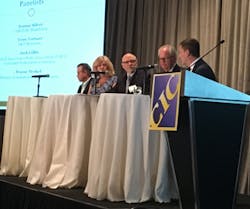CHICAGO — Should all parts — crash repair and mechanical — be certified? In a word, yes, according to a panelist during a CIC presentation in Chicago.
Darrell Amberson with LaMettry’s Collision led the CIC Governmental Committee panel discussion, “Regulatory Impact on Aftermarket Parts,” during the CIC meeting in Chicago, which took place in conjuction to NACE Automechanika 2017. His first question, “Should all parts be certified?” got a simple answer from one panelist. “Yes,” said Jack Gillis, Certified Automotive Parts Association (CAPA), and Consumer Federation of America.
“Certification is a generic term. What we are really looking for is standards. What are the standards that you want to see in place? And then certify to those standards. There is the story of a cement life jacket. It meant the standards perfectly. But the standards were incorrect. The certification is secondary,” Gillis said. “What is the standard we are using to compare those? That is what needs to be fully transparent and scrutinized by the industry. And as parts become more complex, it is even more important that the standards are legitimate, rigid and have the ability to prove that both parts are the same.”
He also stressed that it is critical to determine if the factories themselves are able to consistently produce a product that meets any set standards. “The first step is to determine which factories are actually capable of meeting any certification requirements,” Gillis said.
Certification is important, but more so is parts traceability, said Terry Fortner with LKQ/Keystone. Once a part is deemed unsafe, there needs to be a way to trace where and when those parts were used throughout the industry. LKQ/Keystone, one of the largest purchasers of CAPA certified parts, focuses very heavily on traceability and keeping consumers informed.
“The only way certification is actually valuable to the consumer is if you are tracking the part from beginning to end — the materials that go into it, tracing corrosion resistance, its shape and size, putting it on a car and crash testing it, which no one does. The problem with certification now is market penetration is not at a level that is sufficient,” said Wayne Weikel, Alliance of Automobile Manufacturers. “There are so many issues around certification. But until you fix this collection of problems, it leaves the consumer a little short.”
“I think there is really a place for certified aftermarket parts. Consumers want them. In some cases, it just makes it more affordable for them to fix the car. They have another alternative,” said Jeanne Silver with CARSTAR Mundelein in Mundelein, Ill. “Functionality is going to become a problem. In the consumer’s best interests, if it works and fits and is affordable, then we are going to use them.”
Crash testing
Any certification discussions should be moot until crash testing on every part is implemented, Weikel said. “You must do actual crash testing for government-level certification, whether federal or state, that is the only way they could back it,” he said. “These are high-tech parts that have very specially-designed sections. Unless you are actually crash testing that, I don’t see how any state or federal government can put their stamp on it.”
| Legislation to watch |
|
Holly Wolf, in Government affairs for the Automotive Service Association, discussed current legislation to keep an eye on that is impacting the automotive aftermarket industry. Parts Act, H.R. 1879, S. 812
NY A 6617
TN HB 1098/SB 768
|
Gillis agreed — to a point. “Anything that has safety ramifications in the vehicle needs to be tested to ensure it performs at the same level as the car manufacturer’s part,” he said. “But if there are no safety ramifications, there is no need to do crash testing.”
Understanding consumer consent
Explaining to the consumer what their “consent” to use aftermarket repair parts really means for them is also important. And it is different in every state.
“Our shop tries to explain it as best we can and we want to give the vehicle owner a choice. The way that you choose to communicate that; I really believe the industry should take charge of that and do it. It is up to us as repairers to give consumers that good information and allow them to make informed choices,” Silver says.
Patent problems
The PARTS Act, currently being considered (see sidebar) is not a great alternative for the industry, Weikel says.
“The PARTS Act misses on a lot of points. In the world of innovation and design, if you are going to protect your intellectual property, you should be able to protect that,” he says. “It is discriminatory to one industry, as it is not talking about all industries. The legislation refers to just this one industry and it will benefit only aftermarket parts manufacturers and insurers.”
Gillis says ultimately the PARTS Act drives competition and puts more power back in the consumers’ hands. “It’s the consumer’s call. The concept behind the PARTS Act is when I buy a car I don’t want to be an indentured customer to that vehicle manufacturer company and have to get all my parts and repairs from that company. That is one reason why once the warranty expires, we go to an independent repair shop,” he said.
Many consumer groups are supportive of the PARTS Act because of its encouragement of competition, which leads to improved quality and lower prices, Gillis said. “We need those parts, we need competition, and we need those parts in the marketplace,” he said. “The PARTS Act preserves that (patent) monopoly for 2.5 years. We think it should be zero years. The individual parts do not need the design patent protection.”
Weikel countered that aftermarket parts manufacturers do have an option — they can contract directly with OEM vehicle parts manufacturers. “LKQ has done this. That is what should happen,” he said. “Aftermarket parts should not be treated any differently than parts in any other industry.”


